‘Whatever training is imparted here, it is specialised in nature and that is why we do not train everybody from the Indian infantry here, but a few select people only. The criteria are different for different courses. We have laid down a set of criteria for each of the 16 courses we run. They vary as per the course. Undoubtedly, these criteria are extremely challenging’

Lt Gen Konsam Himalay Singh, PVSM, UYSM, AVSM, YSM-Commandant of the Infantry School, Mhow (Madhya Pradesh) is a highly decorated officer. He is an alumnus of Sainik School and the highly acclaimed National Defence Academy. His service in the Indian Army spans over 39 years. He is the recipient of the Param Vishisht Seva Medal, UYSM, Ati Vishisht Seva Medal and Yudh Seva Medal. He also has several remarkable firsts to his credit, primary among them being that he is the first ever officer from the Northeast region to have achieved the rank of a Lt General in the army, post India’s independence. His extraordinary achievements in the armed forces include his show of gallantry in the Kargil War, commanding a division of the army on the LoC in Jammu and Kashmir (he has five stints to his credit, in that challenging area), being awarded Chief of Army Staff Commendation Card not once, but thrice and authoring a book. In a tell-all interview with the Corporate Citizen given just before he retired recently, Lt Gen Konsam Himalay Singh drives home the point that infantry is still relevant in the day and age of mechanised infantry...
As we all know, infantry schools are premier training institutes of the Indian Army and Infantry is the queen of the battle. At the same time, infantry is also known to be the country's ultimate weapon! When the time comes, it is the infantry that decides the victory or defeat on the battleground with the support of other arms and forces. So that is why we train the officers and men of the infantry and also of other armed forces. In infantry-centric operations, we feel that we do deliver victory.
The AMU has one of the best shooting facilities in the world and not just in India. Besides, it also boasts of a system and facilities wherein championships for young shooters as well as various other shooting competitions of the Indian Army are held. The AMU is known for picking up talent and honing it to the best of its ability. AMU chooses shooters from all over the Indian Army and then they are groomed in accordance with national events, which is also the reason why we had three army men participating in the Olympics. I am very sure that in times to come, we will produce many medal winners in many international events. That apart, we also choose the best coaches based on their availability. In fact, we have coaches from other countries too now. We pick the best ones available in the world.
‘We have a systematic training program for young officers once they are commissioned. In the training or the graduation academies, they are trained to be an officer and a gentleman at the same time. Practical knowledge of the arms is given here. It is known as the Young Officers Course. This particular course comprises commando training’

The courses offered here vary from the basic ones to specialised ones. The former, for instance, would include, handling of specialist weapons, handling of normal weapons and all other types of weapons. As you know, the number of weapons used by the infantry is wide in range. The second is infantry tactics as related to the infantry battalion, company, platoons and even sections-in fact, at all levels of the unit as well as the sub-unit. There are specialised courses as well. For instance, we have commando training which is part of our Infantry School. Other than that, the school also has sniper courses and other similar specialised courses (such as those to do with specialist weapons).
We have a systematic training program for young officers once they are commissioned. In the training or the graduation academies, they are trained to be an officer and a gentleman at the same time. Practical knowledge of the arms et al is given here. It is known as the Young Officers Course. This particular course comprises commando training. Here, the young officers have to undergo training on all weapons. They are also trained on the systems of these weapons and even the tactics of handling the Rifle Company of the infantry. Additionally, we also have a system that ensures that besides these professional activities, we give them ample exposure to communication, personality development, self-improvement, games and sports activities.
The genesis of the current school can be traced back to the School of Musketry at Changla Gali (presently in Pakistan), established way back in 1888. Between the years 1888 and 1948, even before it got its present name and finally relocated to Mhow, it included various segments in various places. The School of Musketry was previously at Satara, and moved to Belgaum afterwards. The Small Arms School was at Pachmarhi and another offshoot at Ahmednagar. The Indian Non Commissioned Officers’ Training School was at Jhansi, and the other two schools at Faizabad and Dehradun.
Post independence, a decision was taken to amalgamate the other institutes, thereby giving birth to the Infantry School, with all the school instructions combined. In January 1948, the Battle, Tactical and Administration School shifted from Dehradun to Mhow in order to merge with the Infantry School. The Commando Wing was raised as a component of the Infantry School in 1964. Until 1971, the school held Junior Command and Senior Officers’ Course. Due to the rise in the capacity of courses being held at the Infantry School and the proposal to introduce a Higher Command Course, a decision was taken to bifurcate the existing School into the College of Combat and the Infantry School. Consequently, the Junior Leaders’ Wing, including the Young Officers and Commando Wings of the School shifted to Belgaum. In the year 1998, the Platoon Commanders’ Wing moved to Belgaum while the Young Officers’ Wing was moved back to Mhow. In 1993, the Army Marksmanship Unit was introduced. The most recent addition was made to the Infantry School in the form of the Non Commissioned Officers’ Academy, established in 2005 at Binnaguri.
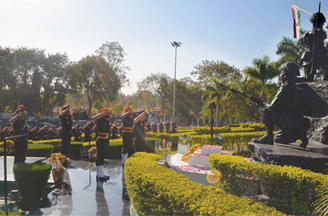
We train some 700-800 officers of the infantry in a year, besides jawans and personnel from other ranks. In addition, we have other officers from foreign countries. We have 17-20 countries sending in their officers for a process here. And as far as other jawans are concerned, we have about 3000 people being trained in a year. As you know, this is not basic training. Whatever training is imparted here, it is specialised in nature and that is why we do not train everybody from the Indian infantry here, but a few select people only. The criteria are different for different courses. We have laid down a set of criteria for each of the 16 courses we run. They vary as per the course. Undoubtedly, these criteria are extremely challenging.
As I mentioned earlier, these are all specialised courses. We train the officers to be sub-unit commanders, detachment commanders and weapon specialists so that they can further train others. We lay a base for those training the entire Indian infantry in their respective units and sub-units.
The Army Marksmanship Unit is a part of the Infantry School where the shooting skills of young aspirants are polished. The AMU is known for producing fine shooters who have gone on to win medals and laurels on the international platform. The list of shooters trained at the AMU boasts of names such as Rajyavardhan Singh Rathore (silver medal at Athens Olympics, 2004). Other than that, nine shooters (of the 36 chosen from India) for the famous Commonwealth Games were trained at AMU alone. Four of them upped the medal tally of India by winning as many as five Gold, two Silver and one Bronze Medal in the sport of shooting.
With the change in technology, various activities as a part of these courses have registered a significant change. For instance, now we have IT courses being run here in addition to the specialised courses. These IT courses are to help adapt to the changes in information technology of the infantry. On the other hand, there is new technology in weapons too. We boast of the best of service techniques. We have adapted to the changing times through our curriculum. I would also like to mention that the Infantry School’s technological absorption is quite less. Infantry sticks to simple, easy to operate weapon systems, relying more on leadership qualities and this is one of the challenges—how to synchronise technology and the war troop on the ground to win wars?
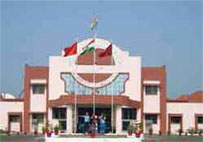
I would say that all of these qualities are inherent in the curriculum. In the commando training, for example, they operate together and undergo vigorous emotional, mental and physical labour. We encourage them to operate in groups. The aim is to inculcate team spirit. However, in the weapons course, the courses are weapon specific. It depends on what kind of weapon is used to determine team spirit.
We have the best of quality instructors in the Indian Infantry. We have Havildar Instructors, JCO Instructors, officer instructors at all levels. All of them are the best and have qualified to become instructors in the courses that they have studied themselves. If they do well as qualified instructors and they have a good service profile, only then are they posted here as instructors, in the case of officers. In the case of Havildars and JCOs, the Army Headquarters takes care of the recruitment and we select the best. We have 160 officers who have been selected as instructors. We have another 350 officers, JCOs and Havildars who train the officers.
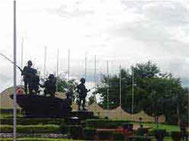
I don’t agree. The western world was of the same opinion too, but then Iraq happened, Afghanistan happened, Syria happened and they realised that one cannot win a battle purely relying on technology, mechanised weapons or infantry. If you recollect, in Iraq, the mechanised forces won the country in a few days but they also realised that it is the boots on the ground that clinched the win.
So the idea of infantry with men on the battleground is still very relevant. Another factor which makes it all the more relevant is that we have long borders in the mountains spread over many kilometres. No amount of mechanised infantry is going to deliver on such a terrain. Yet in the western sector, there will be operations dominated by mechanised forces. The predominance of mechanised forces will continue. But you have all types of agencies, weapons, low-intensity conflicts, conflicts in J and K and the northeast where only infantry can carry out these operations because of the nature of operations and geography.
We have confined ourselves to sub-head, unit head and the listing of the infantry battalions per se. All the mentioned technologies and dimensions will be taken care of by the other establishments as we are primarily dealing with infantry-centric activities of the infantry battalions. That is why we expose them to knowledge on such issues but we do not have a setup for direct training.
As far as space for modern technology is considered, we try to educate them about everything that is related to the infantry battalion and the rifle companies. For example, for our training acts, we incorporate technology for the purpose of training but that does not extend to the arena of space. Space activities and related exposure is provided as the officer grows in his years of service. A cutting edge technology may not be necessary to train an officer. I am of the opinion that they could be trained on this front in the times to come, but as of now, it may not be necessary.
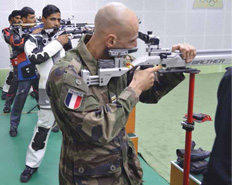
The nature of training of our officers at academies such as the National Defence Academy or the Officers Training Academy or the Indian Naval Academy is such that we focus on inculcating officer like qualities in them as well as grooming them to be thorough gentlemen. This is our first and foremost goal. Once they get a hang of the units, the culture of the Indian Army and its arm of infantry, the officers today are as good or as bad as the officers in the past, although environmental factors have a strong bearing on their attitude and behaviour. People are a lot more exposed to the world of social media these days and all things good and bad that make up the society. It is only natural that in such a climate, their personalities are bound to be moulded significantly. However, to say that they are any less professional or dedicated to the motherland than their predecessors is not right. The only difference between the officers from that age and today’s times is that the current generation of officers have many responsibilities on their shoulders. To conclude, I would say that I do not find much of a difference barring the environmental factors and their exposure to the social media. As far as the question of curriculum is concerned, it undergoes several amendments for the better. I have to say I am quite content with these improvements in the course.
‘Now we have IT courses being run here in addition to the specialised courses. These IT courses are to help adapt to the changes in information technology of the infantry. On the other hand, there is new technology in weapons too. We boast of the best of service techniques. We have adapted to the changing times through our curriculum’
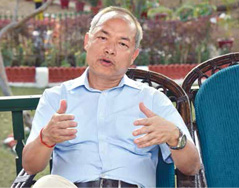

‘I remember there was a gentleman called Major Bahadur. He is no more and Mrs Bahadur is running a school here which is quite popular. It is known as the Colonel’s Academy. I have fond memories of Major Bahadur trying to groom me into a better officer’
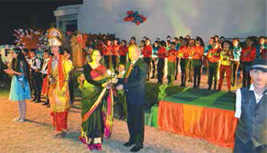
Thirty-eight years ago, I pursued my course in Belgaum. Now, things have changed over the years and these courses are taught in Mhow. From my time, I remember there was a gentleman called Major Bahadur. He is no more and Mrs Bahadur is running a school here which is quite popular. It is known as the Colonel’s Academy. I have fond memories of Major Bahadur trying to groom me into a better officer! Those moments are rather memorable for me. From my commando’s course too, I have sweet memories of heart touching episodes. Primary among them is of the day when they announced, ‘Commandos, we will do a jump now!’ The thought of executing the jump wasn’t exactly scary, but it was a challenging jump to do! Of course, I have done other courses at the Infantry School. Most of the officers here were trained at a tender age.
The requirements of the School of Artillery are different in terms of their infrastructure needs from the government. The Infantry School, on the contrary, has fewer needs. It functions or operates in smaller teams. That automatically reduces our requirements vis-a-vis the School of Artillery, given our system. Having said that, with the kind of system of weapons that we have, we need a large number of them in different types. Compare this with other schools, which will have just two types of tanks and a fewer number of weapons. In the Infantry School, we have a range of weapon systems. These include different arms and services and we have the best infrastructure as of now. We are trying to improve further in order to meet the challenges that the future might bring us.

We expect them to be good rifle company commanders. We expect them to be excellent specialist weapon commanders when they return to their academies.
That has to be the winning of Kargil war, hands down! I was a commanding officer then and in fact, I would also like to share with you that I will be the last Kargil CO serving in the army. (He retired in February this year.) Thereafter, no Commanding Officer from the Kargil victory will be found to be serving in the Indian Army. So, the momentous event was capturing the Pakistani post on 27th June, 1999. That was by far the most memorable event for me—the time when I was the commanding officer of 27 Rajput, and nothing else comes close to it.
As of now, there are no definite plans. One can plan but it may or may not work out. However, what I will be pursuing passionately is the social upliftment and empowerment of the poor and weak sections of the society. I may go to a place where there is no peace and lawlessness prevails. But it is the state to which I belong—Manipur. All I know right now is that I am heading to Manipur. That said, I am also dedicated to the cause of security, whether internal or external with reference to India and North East India, in particular. I have also submitted my thesis about the North East around this issue. A PhD thesis on a similar project is in progress too.
By Namrata Gulati Sapra